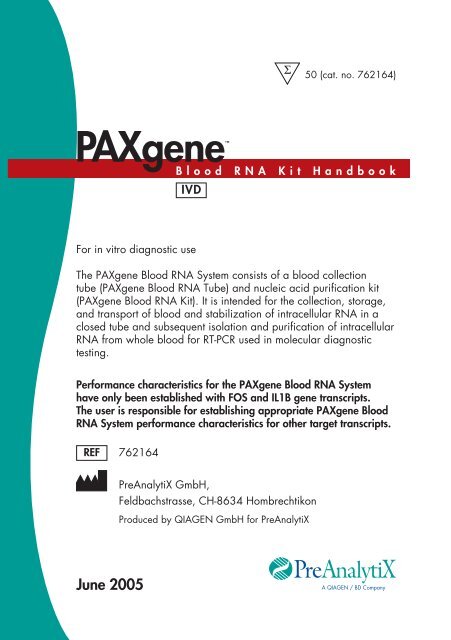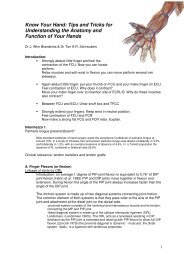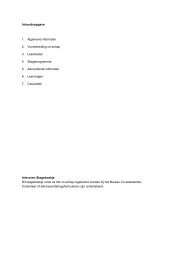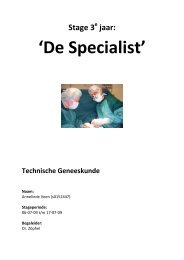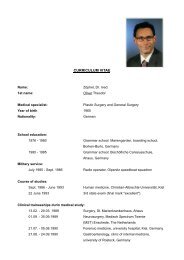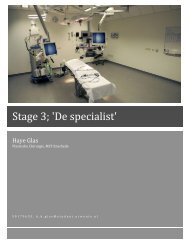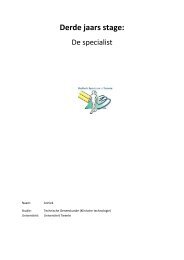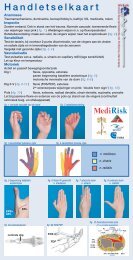PaxGene Blood RNA Kit Handbook - Plastisch chirurgen
PaxGene Blood RNA Kit Handbook - Plastisch chirurgen
PaxGene Blood RNA Kit Handbook - Plastisch chirurgen
Create successful ePaper yourself
Turn your PDF publications into a flip-book with our unique Google optimized e-Paper software.
Σ50 (cat. no. 762164)PAXgene<strong>Blood</strong> <strong>RNA</strong> <strong>Kit</strong> <strong>Handbook</strong>IVDFor in vitro diagnostic useThe PAXgene <strong>Blood</strong> <strong>RNA</strong> System consists of a blood collectiontube (PAXgene <strong>Blood</strong> <strong>RNA</strong> Tube) and nucleic acid purification kit(PAXgene <strong>Blood</strong> <strong>RNA</strong> <strong>Kit</strong>). It is intended for the collection, storage,and transport of blood and stabilization of intracellular <strong>RNA</strong> in aclosed tube and subsequent isolation and purification of intracellular<strong>RNA</strong> from whole blood for RT-PCR used in molecular diagnostictesting.Performance characteristics for the PAXgene <strong>Blood</strong> <strong>RNA</strong> Systemhave only been established with FOS and IL1B gene transcripts.The user is responsible for establishing appropriate PAXgene <strong>Blood</strong><strong>RNA</strong> System performance characteristics for other target transcripts.REF762164PreAnalytiX GmbH,Feldbachstrasse, CH-8634 HombrechtikonProduced by QIAGEN GmbH for PreAnalytiXJune 2005
Trademarks: PAXgene, PreAnalytiX (PreAnalytiX GmbH); BD Vacutainer ® , BD Hemogard, Safety-Lok (Becton, Dickinson and Company,Franklin Lakes, NJ, USA); Eppendorf ® (Eppendorf-Netheler-Hinz GmbH).The PCR process is covered by US Patents 4,683,195 and 4,683,202 and foreign equivalents issued to Hoffmann-La-Roche AG.Registered names, trademarks, etc. used in this document, even when not specifically marked as such, are not to be considered unprotected by law.© 2005 PreAnalytiX GmbH, all rights reserved.2PAXgene <strong>Blood</strong> <strong>RNA</strong> <strong>Kit</strong> <strong>Handbook</strong> 06/2005
ContentsExplanation of Symbols 4<strong>Kit</strong> Contents 5Storage Conditions 5Intended Use 6Product Use Limitations 6Quality Control 6Technical Assistance 6Safety Information 7Introduction 9Principle and procedure 9Sample collection and stabilization 9<strong>RNA</strong> concentration and purification 12Equipment and Reagents to Be Supplied by User 21ProtocolPurification of Total <strong>RNA</strong> from Human Whole <strong>Blood</strong> Collected into PAXgene<strong>Blood</strong> <strong>RNA</strong> Tubes 22Troubleshooting Guide 27Appendix A: General Remarks on Handling <strong>RNA</strong> 29Appendix B: Quantification and Determination of Quality of Total <strong>RNA</strong> 30Appendix C: Handling PAXgene <strong>Blood</strong> <strong>RNA</strong> Tubes 32Ordering Information 33PAXgene <strong>Blood</strong> <strong>RNA</strong> <strong>Kit</strong> <strong>Handbook</strong> 06/2005 3
Explanation of SymbolsΣ iContains sufficient for testsConsult instructions for useUse byIVDREFLOTIn vitro diagnostic medical deviceCatalog numberBatch codeTemperature limitationUpper limit of temperatureManufacturer4PAXgene <strong>Blood</strong> <strong>RNA</strong> <strong>Kit</strong> <strong>Handbook</strong> 06/2005
Intended UseThe PAXgene <strong>Blood</strong> <strong>RNA</strong> <strong>Kit</strong> is for the purification of intracellular <strong>RNA</strong> from whole bloodcollected in the PAXgene <strong>Blood</strong> <strong>RNA</strong> Tube. When the kit is used in conjunction with thePAXgene <strong>Blood</strong> <strong>RNA</strong> Tube, the system provides purified intracellular <strong>RNA</strong> from wholeblood for RT-PCR used in molecular diagnostic testing. See the PAXgene <strong>Blood</strong> <strong>RNA</strong>Tube Product Circular for information about the use of PAXgene <strong>Blood</strong> <strong>RNA</strong> Tubes.Performance characteristics for the PAXgene <strong>Blood</strong> <strong>RNA</strong> System have only beenestablished with FOS and IL1B gene transcripts. The user is responsible for establishingappropriate PAXgene <strong>Blood</strong> <strong>RNA</strong> System performance characteristics for other targettranscripts.Product Use LimitationsThe PAXgene <strong>Blood</strong> <strong>RNA</strong> <strong>Kit</strong> is intended for purification of intracellular <strong>RNA</strong> from humanwhole blood (4.8 x 10 6 – 1.1 x 10 7 leukocytes/ml) for in vitro diagnostics applications.It is not for the purification of genomic DNA or viral nucleic acids from human wholeblood. Due to the limited number of transcripts validated for stabilization specifications(FOS and IL1B gene transcripts), the performance characteristics have not beenestablished for all transcripts. Laboratory personnel should review the manufacturer’sdata and their own data to determine whether validation is necessary for othertranscripts.Quality ControlIn accordance with QIAGEN’s ISO-certified Total Quality Management System, eachlot of PAXgene <strong>Blood</strong> <strong>RNA</strong> <strong>Kit</strong> is tested against predetermined specifications to ensureconsistent product quality.Technical AssistanceAt QIAGEN we pride ourselves on the quality and availability of our technical support.Our Technical Service Departments are staffed by experienced scientists with extensivepractical and theoretical expertise in molecular biology and the use of PreAnalytiXproducts. If you have any questions regarding the PAXgene <strong>Blood</strong> <strong>RNA</strong> <strong>Kit</strong>, please donot hesitate to contact us.For technical assistance and more information please call QIAGEN Technical Service(see page 34).6PAXgene <strong>Blood</strong> <strong>RNA</strong> <strong>Kit</strong> <strong>Handbook</strong> 06/2005
Safety InformationWhen working with chemicals, always wear a suitable lab coat, disposable gloves,and protective goggles.To avoid the risk of infection (e.g., from HIV or Hepatitis B viruses) or injury whenworking with biological and chemical materials, always wear a suitable lab coat,disposable gloves, and protective goggles. For more information, please consult theappropriate material safety data sheets (MSDSs). These are available online inconvenient and compact PDF format at www.preanalytix.com/rna msds.asp whereyou can find, view, and print the MSDSs for this kit.CAUTION: DO NOT add bleach or acidic solutions directly to the sample-preparationwaste.Buffers BR2 and BR3 contain guanidine thiocyanate, which can form highly reactivecompounds when combined with bleach. If Buffer BR2 or Buffer BR3 is spilt, clean withsuitable laboratory detergent and water. If liquid containing potentially infectiousagents is spilt, clean the affected area first with laboratory detergent and water, andthen with 1% (v/v) sodium hypochlorite.The <strong>RNA</strong> stabilizing solution and blood mixture from the PAXgene <strong>Blood</strong> <strong>RNA</strong> Tube canbe disinfected using 1 volume of commercial bleach solution (5% sodium hypochlorite)per 9 volumes of the <strong>RNA</strong> stabilizing solution and blood mixture.Sample-preparation waste, such as supernatants from centrifugation steps in the <strong>RNA</strong>purification procedure, is to be considered potentially infectious. Before disposal, thewaste must be autoclaved or incinerated to destroy any infectious material.The following risk and safety phrases apply to components of the PAXgene <strong>Blood</strong> <strong>RNA</strong><strong>Kit</strong>. See the PAXgene <strong>Blood</strong> <strong>RNA</strong> Tube Product Circular for safety information aboutPAXgene <strong>Blood</strong> <strong>RNA</strong> Tubes.Buffer BR2XnContains guanidine thiocyanate: harmful (Xn). Risk and safety phrases:*R20/21/22-32, S13-26-36-46* R10: Flammable; R20/21/22: Harmful by inhalation, in contact with skin and if swallowed;R32: Contact with acids liberates very toxic gas; R36/37/38: Irritating to eyes, respiratory system and skin;R42/43: May cause sensitization by inhalation and skin contact; S13: Keep away from food, drink andanimal feedingstuffs; S22: Do not breathe dust; S23: Do not breathe spray; S24: Avoid contact with skin;S26: In case of contact with eyes, rinse immediately with plenty of water and seek medical advice;S36: Wear suitable protective clothing; S36/37: Wear suitable protective clothing and gloves;S46: If swallowed, seek medical advice immediately and show this container or label.PAXgene <strong>Blood</strong> <strong>RNA</strong> <strong>Kit</strong> <strong>Handbook</strong> 06/2005 7
Buffer BR3Contains ethanol: flammable. Risk phrase:* R10Proteinase KXnContains proteinase K (Tritirachium album): sensitizer, irritant. Risk and safety phrases:*R36/37/38-42/43, S23-24-26-36/37DNase IXnContains deoxyribonuclease (bovine): sensitizer. Risk and safety phrases:* R42/43,S22-24-26-36/3724-hour emergency informationEmergency medical information in English, French, and German can be obtained24 hours a day from:Poison Information Center Mainz, GermanyTel: +49-6131-19240* R10: Flammable; R20/21/22: Harmful by inhalation, in contact with skin and if swallowed;R32: Contact with acids liberates very toxic gas; R36/37/38: Irritating to eyes, respiratory system and skin;R42/43: May cause sensitization by inhalation and skin contact; S13: Keep away from food, drink andanimal feedingstuffs; S22: Do not breathe dust; S23: Do not breathe spray; S24: Avoid contact with skin;S26: In case of contact with eyes, rinse immediately with plenty of water and seek medical advice;S36: Wear suitable protective clothing; S36/37: Wear suitable protective clothing and gloves;S46: If swallowed, seek medical advice immediately and show this container or label.8PAXgene <strong>Blood</strong> <strong>RNA</strong> <strong>Kit</strong> <strong>Handbook</strong> 06/2005
IntroductionCollection of whole blood is the first step in many molecular assays used to study cellular<strong>RNA</strong>. However, a major problem in such experiments is the instability of the cellular<strong>RNA</strong> profile in vitro. Studies at PreAnalytiX have shown that the copy numbers ofindividual m<strong>RNA</strong> species in whole blood can change more than 1000-fold duringstorage or transport at room temperature.* This is caused both by rapid <strong>RNA</strong>degradation and by induced expression of certain genes after the blood is drawn. Suchchanges in the <strong>RNA</strong> expression profile make reliable studies of gene expressionimpossible. A method that preserves the <strong>RNA</strong> expression profile during and afterphlebotomy is therefore essential for accurate analysis of gene expression in humanwhole blood.Principle and procedurePreAnalytiX has developed a new system that enables the collection, stabilization,storage, and transportation of whole blood specimens, together with a rapid andefficient protocol for purification of intracellular <strong>RNA</strong>. The system requires the use ofPAXgene <strong>Blood</strong> <strong>RNA</strong> Tubes (US Patents 6,602,718 and 6,617,170) for bloodcollection and <strong>RNA</strong> stabilization, followed by <strong>RNA</strong> purification using the PAXgene<strong>Blood</strong> <strong>RNA</strong> <strong>Kit</strong>.Sample collection and stabilizationPAXgene <strong>Blood</strong> <strong>RNA</strong> Tubes contain a proprietary reagent composition based on apatented <strong>RNA</strong> stabilization technology. This reagent composition protects <strong>RNA</strong>molecules from degradation by RNases and minimizes induction of gene expression.PAXgene <strong>Blood</strong> <strong>RNA</strong> Tubes are intended for the collection of whole blood andstabilization of cellular <strong>RNA</strong> for up to 3 days at 18–25°C (Figure 1, page 10) or up to5 days at 2–8°C (Figure 2, page 11). Currently available data shows stabilization ofcellular <strong>RNA</strong> for at least 6 months at –20°C or –70°C. For more information fromongoing studies evaluating stability for longer time periods, please contact QIAGENTechnical Services.The actual duration of <strong>RNA</strong> stabilization may vary depending upon the species ofcellular <strong>RNA</strong> and the downstream application used. Due to the limited number oftranscripts validated for stabilization specifications (FOS and IL1B gene transcripts), theperformance characteristics have not been established for all transcripts. Laboratorypersonnel should review the manufacturer’s data and their own data to determinewhether validation is necessary for other transcripts.* Rainen, L. et al. (2002) Stabilization of m<strong>RNA</strong> expression in whole blood samples. Clin. Chem. 48, 1883.PAXgene <strong>Blood</strong> <strong>RNA</strong> <strong>Kit</strong> <strong>Handbook</strong> 06/2005 9
<strong>RNA</strong> Stability in <strong>Blood</strong> Samples at 18–25°CA321∆∆C T0–1–2–30 1 2 3Storage (days)B321∆∆C T0–1–2–30 1 2 3Storage (days)Figure 1 <strong>Blood</strong> was drawn from 10 donors, with duplicate samples, and stored at 18–25°C for theindicated number of days, followed by total <strong>RNA</strong> purification. <strong>Blood</strong> was collected and stored in PAXgene<strong>Blood</strong> <strong>RNA</strong> Tubes, and total <strong>RNA</strong> was purified using the PAXgene <strong>Blood</strong> <strong>RNA</strong> <strong>Kit</strong>. Relative transcript levels ofA FOS and B IL1B were determined by real-time, duplex RT-PCR, using 18S r<strong>RNA</strong> as an internal standard.The values for all samples are plotted (20 data sets for each gene, blue lines), with means (red lines) andstandard deviations (black bars) of all samples shown. The dashed lines indicate the ±3x total precision of theassays (FOS: 2.34 C T ; IL1B: 1.93 C T ).10PAXgene <strong>Blood</strong> <strong>RNA</strong> <strong>Kit</strong> <strong>Handbook</strong> 06/2005
<strong>RNA</strong> Stability in <strong>Blood</strong> Samples at 2–8°CA321∆∆C T0–1–2–30 1 2 3 4 5Storage (days)B321∆∆C T0–1–2–30 1 2 3 4 5Storage (days)Figure 2 <strong>Blood</strong> was drawn and total <strong>RNA</strong> purified, after storage at 2–8°C , as described in Figure 1.Relative transcript levels of A FOS and B IL1B were determined by real-time, duplex RT-PCR, using 18Sr<strong>RNA</strong> as an internal standard. The values for all samples are plotted (20 data sets for each gene, blue lines),with means (red lines) and standard deviations (black bars) of all samples shown. The dashed lines indicatethe ±3x total precision of the assays (FOS: 2.34 C T ; IL1B: 1.93 C T ).PAXgene <strong>Blood</strong> <strong>RNA</strong> <strong>Kit</strong> <strong>Handbook</strong> 06/2005 11
<strong>RNA</strong> concentration and purificationThe PAXgene <strong>Blood</strong> <strong>RNA</strong> <strong>Kit</strong> is for the purification of total <strong>RNA</strong> from 2.5 ml humanwhole blood collected in a PAXgene <strong>Blood</strong> <strong>RNA</strong> Tube. The procedure is simple (seeflowchart, page 13). Purification begins with a centrifugation step to pellet nucleic acidsin the PAXgene <strong>Blood</strong> <strong>RNA</strong> Tube. The pellet is washed and resuspended, and incubatedin optimized buffers together with proteinase K to bring about protein digestion. Anadditional centrifugation through the PAXgene Shredder spin column is carried out tohomogenize the cell lysate and remove residual cell debris, and the supernatant of theflow-through fraction is transferred to a fresh microcentrifuge tube. Ethanol is added toadjust binding conditions, and the lysate is applied to a PAXgene <strong>RNA</strong> spin column.During a brief centrifugation, <strong>RNA</strong> is selectively bound to the PAXgene silica membraneas contaminants pass through. Remaining contaminants are removed in several efficientwash steps. Between the first and second wash steps, the membrane is treated withDNase I to remove bound DNA. After the wash steps, <strong>RNA</strong> is eluted in Buffer BR5.Total <strong>RNA</strong> purified using the PAXgene <strong>Blood</strong> <strong>RNA</strong> System is highly pure, with A 260 /A 280values between 1.8 and 2.2 and ≤1.0% (w/w) genomic DNA. At least 95% of samplesshow no inhibition in RT-PCR, when using up to 30% of the eluate.Average sample preparation time (based on data from 12 sample preps) isapproximately 90 minutes, with only 40 minutes of hands-on time. <strong>RNA</strong> yields from2.5 ml healthy human whole blood are ≥3 µg for ≥95% of the samples processed. Sinceyields are highly donor-dependent, individual yields may vary. For individual donors,the PAXgene <strong>Blood</strong> <strong>RNA</strong> System provides highly reproducible and repeatable yields(Figures 3 and 4, pages 14 and 15) and reproducible and repeatable RT-PCR(Figures 5 and 6, pages 18 and 19), making it highly robust for clinical diagnostic tests.12PAXgene <strong>Blood</strong> <strong>RNA</strong> <strong>Kit</strong> <strong>Handbook</strong> 06/2005
The PAXgene <strong>Blood</strong> <strong>RNA</strong> Procedure<strong>Blood</strong>IncubateTransfer to PAXgeneShredder Spin ColumnMixTransfer supernatant of flow-throughto microcentrifuge tubeAdd ethanolLoad on PAXgene <strong>RNA</strong>Spin ColumnWash pelletBind total <strong>RNA</strong>WashDigest DNAResuspendTransfer tomicrocentrifugetubeAdd proteinase Kand binding bufferWashEluteHeat to 65°CReady-to-use <strong>RNA</strong>PAXgene <strong>Blood</strong> <strong>RNA</strong> <strong>Kit</strong> <strong>Handbook</strong> 06/2005 13
A2420Reproducible and Repeatable <strong>RNA</strong> PurificationABC<strong>RNA</strong> yield (µg/2.5 ml blood)16128401 2 3 4 5 6 7 8 9 10 11 12 13 14DonorB24Mean of <strong>RNA</strong> yield (µg/2.5 ml blood)2016128401 2 3 4 5 6 7 8 9 10 11 12 13 14DonorFigure 3 Quadruplicate blood samples from 14 donors were processed by each of 3 technicians (A, B, C).Three sets of equipment were used, and all samples prepared by a single technician were processed using thesame equipment. A Means and standard deviations of <strong>RNA</strong> yield per replicate samples from the samedonors and different technicians are shown. B Twelve replicate blood samples from each of 14 donors wereprocessed by the 3 different technicians. Means and standard deviations of <strong>RNA</strong> yield per samples from thesame donors and all technicians are presented. For all <strong>RNA</strong> samples, A 260 /A 280 ratios ranged from 1.8 to2.2.14PAXgene <strong>Blood</strong> <strong>RNA</strong> <strong>Kit</strong> <strong>Handbook</strong> 06/2005
Figure 3 indicates the overall repeatability and reproducibility of the PAXgene <strong>Blood</strong><strong>RNA</strong> System. Additional studies were conducted to show the influence of differentPAXgene <strong>Blood</strong> <strong>RNA</strong> kit lots and different operators on the reproducibility of <strong>RNA</strong> yieldand real time RT-PCR performance. As pooled blood samples instead of individualPAXgene tubes were used for these studies, the results do not reflect the systemrepeatability, including fluctuation between individual blood draws, but only therepeatability of the sample preparation (see Figure 4).Repeatability and Reproducibility of <strong>RNA</strong> Yield for Different Operators and PAXgene<strong>Blood</strong> <strong>RNA</strong> <strong>Kit</strong> Lots Using Pooled <strong>Blood</strong> SamplesA14121086420Lot 1User 1User 2User 3Lot 2User 1User 2User 3Lot 3User 1User 2User 31 2 3 4 5 6 7 8 9 10Donor poolBCV of <strong>RNA</strong> yield (%)5040302010Lot 1User 1User 2User 3Lot 2User 1User 2User 3Lot 3User 1User 2User 301 2 3 4 5 6 7 8 9 10Donor poolFigure 4 <strong>Blood</strong> samples from 30 different donors were collected in PAXgene <strong>Blood</strong> <strong>RNA</strong> tubes (12 tubesper donor, 360 tubes in total). The contents of the tubes from 3 donors were pooled and subsequentlyre-aliquoted into 36 samples. These 36 samples per 3-donor-pool were processed by 3 different operators.Each operator used 3 different PAXgene <strong>Blood</strong> <strong>RNA</strong> <strong>Kit</strong> lots for the extraction and processed quadruplicatesamples from each of the 10 donor pools. A <strong>RNA</strong> yield and standard deviation for every operator–lotcombination. Quadruplicate blood samples from 10 donor pools were processed by 3 different operators(User 1, User 2, User 3) with each of 3 kit lots (Lot 1, Lot 2, Lot 3). The mean yields (columns) and standarddeviations (error bars) per quadruplicate sample from the same donor pool for different operator and differentkit lot are presented. B CV of <strong>RNA</strong> yield per donor pool for all operator–lot combinations (User 1, User 2,User 3; Lot 1, Lot 2, Lot 3) as calculated from the mean yield and standard deviation of the yield shown inFigure 4A.PAXgene <strong>Blood</strong> <strong>RNA</strong> <strong>Kit</strong> <strong>Handbook</strong> 06/2005 15
Table 1A. Reproducibility within Each Lot and within Each UserDonor pool 1 Donor pool 6 Donor pool 9 Donor pool 105.1 x 10 6 cells/ml 6.5 x 10 6 cells/ml 8.4 x 10 6 cells/ml 10.2 x 10 6 cells/mlMean SD CV Mean SD CV Mean SD CV Mean SD CVCombination of data yield (µg) (µg) (%) yield (µg) (µg) (%) yield (µg) (µg) (%) yield (µg) (µg) (%)Lot 1, user 1 8.03 0.42 5 9.55 0.99 10 7.52 0.41 6 7.96 0.49 6Lot 1, user 2 7.98 1.17 15 9.38 1.94 21 8.82 1.72 19 8.90 0.76 9Lot 1, user 3 7.87 0.45 6 10.71 0.65 6 10.14 1.46 14 10.22 1.29 13Lot 2, user 1 7.32 0.98 13 9.78 1.89 19 6.92 0.27 4 7.63 1.23 16Lot 2, user 2 6.09 1.04 17 9.82 2.83 29 7.20 0.71 10 7.00 0.56 8Lot 2, user 3 6.87 0.31 4 10.37 0.74 7 9.14 1.52 17 11.56 1.21 10Lot 3, user 1 7.04 0.90 13 8.96 0.68 8 8.18 0.76 9 7.85 0.82 10Lot 3, user 2 6.98 1.22 17 7.73 0.97 13 6.41 0.88 14 8.88 2.17 24Lot 3, user 3 8.78 0.89 10 10.59 1.94 18 10.78 0.56 5 10.88 0.37 3Table 1B. Reproducibility within Each User and between All LotsDonor pool 1 Donor pool 6 Donor pool 9 Donor pool 105.1 x 10 6 cells/ml 6.5 x 10 6 cells/ml 8.4 x 10 6 cells/ml 10.2 x 10 6 cells/mlMean SD CV Mean SD CV Mean SD CV Mean SD CVCombination of data yield (µg) (µg) (%) yield (µg) (µg) (%) yield (µg) (µg) (%) yield (µg) (µg) (%)User 1, all lots 7.46 0.85 11 9.43 1.22 13 7.54 0.72 10 7.81 0.82 11User 2, all lots 7.02 1.31 19 8.98 2.09 23 7.48 1.50 20 8.26 1.54 19User 3, all lots 7.84 0.98 13 10.56 1.15 11 10.02 1.34 13 10.89 1.10 1016PAXgene <strong>Blood</strong> <strong>RNA</strong> <strong>Kit</strong> <strong>Handbook</strong> 06/2005
Table 1C. Reproducibility within Each Lot and between All UsersDonor pool 1 Donor pool 6 Donor pool 9 Donor pool 105.1 x 10 6 cells/ml 6.5 x 10 6 cells/ml 8.4 x 10 6 cells/ml 10.2 x 10 6 cells/mlMean SD CV Mean SD CV Mean SD CV Mean SD CVCombination of data yield (µg) (µg) (%) yield (µg) (µg) (%) yield (µg) (µg) (%) yield (µg) (µg) (%)Lot 1, all users 7.96 0.69 9 9.88 1.34 14 8.83 1.63 19 9.02 1.27 14Lot 2, all users 6.76 0.93 14 9.99 1.84 18 7.75 1.36 18 8.73 2.31 26Lot 3, all users 7.60 1.27 17 9.09 1.71 19 8.46 1.99 24 9.20 1.80 20Table 1D. Reproducibility between All Lots and All UsersDonor pool 1 Donor pool 6 Donor pool 9 Donor pool 105.1 x 10 6 cell/ml 6.5 x 10 6 cell/ml 8.4 x 10 6 cell/ml 10.2 x 10 6 cell/mlMean SD CV Mean SD CV Mean SD CV Mean SD CVCombination of data yield (µg) (mg) (%) yield (µg) (µg) (%) yield (µg) (µg) (%) yield (µg) (µg) (%)All lots and all users 7.44 1.09 15 9.66 1.65 17 8.35 1.70 20 8.99 1.80 20Detailed analysis of 4 representative donor pools. The pools were selected according to the white blood cell count and reflect the upper, medium, and the lowervalues of the normal range of white blood cell counts (4.8 x 10 6 – 1.1 x 10 7 leukocytes/ml). The white blood cell count represents the mean value of the 3 whiteblood cell counts from the 3 donors per donor pool.PAXgene <strong>Blood</strong> <strong>RNA</strong> <strong>Kit</strong> <strong>Handbook</strong> 06/2005 17
Reproducibility of RT-PCR — between UsersA321∆∆C T0–1–2–31 2 3UserB321∆∆C T0–1–2–31 2 3UserFigure 5 <strong>RNA</strong> purified in the experiment described in Figure 4 was used for real-time RT-PCR. Relativetranscript levels of A FOS and B IL1B were determined by real-time, duplex RT-PCR using 18S r<strong>RNA</strong> as aninternal standard. The values for all samples are plotted, relative to the values for user 1 (10 donor poolsx 3 kit lots x 4 replicates = 120 data sets for each gene), with means (red lines) and standard deviations(black bars) or all samples shown. The dashed lines indicate the ± 3x total precision of the assays (FOS:2.34 C T ; IL1B, 1.93 C T ).18PAXgene <strong>Blood</strong> <strong>RNA</strong> <strong>Kit</strong> <strong>Handbook</strong> 06/2005
Reproducibility of RT-PCR — between <strong>Kit</strong> LotsA321∆∆C T0–1–2–31 2 3LotB321∆∆C T0–1–2–31 2 3LotFigure 6 <strong>RNA</strong> purified in the experiment described in Figure 4 was used for real-time RT-PCR. Relativetranscript levels of A FOS and B IL1B were determined by real-time, duplex RT-PCR using 18S r<strong>RNA</strong> as aninternal standard. The values for all samples are plotted, relative to the values for kit lot 1 (10 donor poolsx 3 users x 4 replicates = 120 data sets for each gene), with means (red lines) and standard deviations(black bars) or all samples shown. The dashed lines indicate the ± 3x total precision of the assays (FOS:2.34 C T ; IL1B, 1.93 C T ).PAXgene <strong>Blood</strong> <strong>RNA</strong> <strong>Kit</strong> <strong>Handbook</strong> 06/2005 19
Table 2. Summary of RT-PCR Data from Figures 5 and 6Test system FOS/18S r<strong>RNA</strong> assay IL1B/18S r<strong>RNA</strong> assayComparison of data Mean ± SD Mean ± SD(DDC T ) (DDC T ) (DDC T ) (DDC T )Reproducibility within each user and between all lotsAll users, lot 1 – lot 1 0.00 0.00 0.00 0.00All users, lot 1 – lot 2 –0.03 0.48 –0.07 0.66All users, lot 1 – lot 3 –0.21 0.52 0.11 0.71Reproducibility within each lot and between all usersAll lots, user 1 – user 1 0.00 0.00 0.00 0.00All lots, user 1 – user 2 –0.46 0.44 –0.06 0.69All lots, user 1 – user 3 –0.31 0.60 –0.15 0.71User: Technician, performed the study.Lot: Number of kit lot used in this study.SD: Standard deviation.Mean DDC T values (N = 120) and standard deviations are shown for the data presented in Figures 5 and 6.20PAXgene <strong>Blood</strong> <strong>RNA</strong> <strong>Kit</strong> <strong>Handbook</strong> 06/2005
Equipment and Reagents to Be Supplied by UserWhen working with chemicals, always wear a suitable lab coat, disposable gloves,and protective goggles. For more information, consult the appropriate material safetydata sheets (MSDSs), available from the product supplier.• PAXgene <strong>Blood</strong> <strong>RNA</strong> Tubes (cat. no. 762165)• Ethanol (96–100%, purity grade p.a.)• Pipets* (10 µl – 4 ml)• Sterile, aerosol-barrier, RNase-free pipet tips †• Graduated cylinder ‡• Variable-speed microcentrifuge* capable of attaining 1000–8000 x g, andequipped with a rotor for 2 ml microcentrifuge tubes• Centrifuge* capable of attaining 3000–5000 x g, and equipped with a swingoutrotor and buckets to hold PAXgene <strong>Blood</strong> <strong>RNA</strong> Tubes• Shaker–incubator* capable of incubating at 55°C and 65°C and shaking at ≥400rpm, not exceeding 1400 rpm (e.g., Eppendorf ® Thermomixer Compact, orequivalent)• Vortex mixer*• Disposable gloves* Ensure that instruments have been checked and calibrated regularly according to the manufacturer’srecommendations.†Ensure that you are familiar with the guidelines on handling <strong>RNA</strong> (Appendix A, page 29).‡For the addition of ethanol to Buffer BR4 concentrate.PAXgene <strong>Blood</strong> <strong>RNA</strong> <strong>Kit</strong> <strong>Handbook</strong> 06/2005 21
Protocol: Purification of Total <strong>RNA</strong> from Human Whole<strong>Blood</strong> Collected into PAXgene <strong>Blood</strong> <strong>RNA</strong> TubesProtocolImportant points before starting• Make sure that the kit box is intact and undamaged, and that buffers have notleaked. Do not use a kit that has been damaged.• When using a pipet, ensure that it is set to the correct volume, and that liquid iscarefully and completely aspirated and dispensed.• To avoid transferring samples to the wrong tube or spin column, ensure that alltubes and spin columns are properly labeled. Label the lid and the body of eachtube. For spin columns, label the body of its processing tube. Close each tube orspin column after liquid is transferred to it.• Spillages of samples and buffers during the procedure may reduce the yield andpurity of <strong>RNA</strong>.• Unless otherwise indicated, all steps of this protocol, including centrifugation steps,should be carried out at room temperature (15–25°C).• Because of the sensitivity of nucleic acid amplification technologies, the followingprecautions are necessary when handling samples to avoid cross-contamination:• Carefully pipet the sample into the spin column without moistening the rim ofthe column.• Always change pipet tips between liquid transfers. Use aerosol-barrier pipettips.• Avoid touching the spin column membrane with the pipet tip.• After vortexing or heating a microcentrifuge tube, briefly centrifuge it toremove drops from the inside of the lid.• Wear gloves throughout the entire procedure. In case of contact betweengloves and sample, change gloves immediately.• Close the spin column before placing it in the microcentrifuge. Centrifuge asdescribed in the procedure.• Open only one spin column at a time, and take care to avoid generatingaerosols.• For efficient parallel processing of multiple samples, fill a rack withprocessing tubes to which the spin columns can be transferred aftercentrifugation. Discard the used processing tubes containing flow-through,and place the new processing tubes containing spin columns directly in themicrocentrifuge.22PAXgene <strong>Blood</strong> <strong>RNA</strong> <strong>Kit</strong> <strong>Handbook</strong> 06/2005
Things to do before starting• <strong>Blood</strong> must be collected in PAXgene <strong>Blood</strong> <strong>RNA</strong> Tubes according to the instructionsin the PAXgene <strong>Blood</strong> <strong>RNA</strong> Tube Product Circular. If necessary, see Appendix C(page 32) for recommendations on handling PAXgene <strong>Blood</strong> <strong>RNA</strong> Tubes.• Ensure that the PAXgene <strong>Blood</strong> <strong>RNA</strong> Tubes are incubated for at least 2 hours atroom temperature after blood collection to ensure complete lysis of blood cells.Incubation of the PAXgene <strong>Blood</strong> <strong>RNA</strong> Tube overnight may increase yields. If thePAXgene <strong>Blood</strong> <strong>RNA</strong> Tube was stored at 2–8°C or –20°C or –70°C after bloodcollection, first equilibrate it to room temperature, and then store it at roomtemperature for 2 hours before starting the procedure.• Read the safety information on page 7.• Read the guidelines on handling <strong>RNA</strong> (Appendix A, page 29).• Ensure that instruments, such as pipets and the shaker–incubator, have beenchecked and calibrated regularly according to the manufacturer’s recommendations.• A shaker–incubator is required in steps 5 and 20. Set the temperature of theshaker–incubator to 55°C.• Buffer BR2 may form a precipitate upon storage. If necessary, warm to 37°C todissolve.• Buffer BR4 is supplied as a concentrate. Before using for the first time, add4 volumes of ethanol (96–100%, purity grade p.a.) as indicated on the bottle toobtain a working solution.• If using the RNase-Free DNase Set for the first time, prepare DNase I stock solution.Dissolve the solid DNase I (1500 Kunitz units)* in 550 µl of the RNase-free waterprovided with the set. Take care that no DNase I is lost when opening the vial. Donot vortex the reconstituted DNase I. DNase I is especially sensitive to physicaldenaturation. Mixing should only be carried out by gently inverting the tube.• Current data shows that reconstituted DNase I can be stored at 2–8°C for up to6 weeks. For long-term storage of DNase I, remove the stock solution from the glassvial, divide it into single-use aliquots (use the 1.5 ml microcentrifuge tubes suppliedwith the kit; there are enough for 5 aliquots), and store at –20°C for up to6 months. Thawed aliquots can be stored at 2–8°C for up to 6 weeks. Do notrefreeze the aliquots after thawing. Ongoing studies may modify these times.Contact QIAGEN Technical Services for current details.• When reconstituting and aliquoting DNase I, ensure that you follow the guidelinesfor handling <strong>RNA</strong> (Appendix A, page 29).Protocol* Kunitz units are the commonly used units for measuring DNase I, defined as the amount of DNase I thatcauses an increase in A 260 of 0.001 per minute per milliliter at 25°C, pH 5.0, with highly polymerizedDNA as the substrate (Kunitz, M. (1950) J. Gen. Physiol. 33, 349 and 363).PAXgene <strong>Blood</strong> <strong>RNA</strong> <strong>Kit</strong> <strong>Handbook</strong> 06/2005 23
ProtocolProcedure1. Centrifuge the PAXgene <strong>Blood</strong> <strong>RNA</strong> Tube for 10 minutes at 3000–5000 xgusing aswing-out rotor.Note: Ensure that the blood sample has been incubated in the PAXgene <strong>Blood</strong><strong>RNA</strong> Tube for a minimum of 2 hours at room temperature (15–25°C), in order toachieve complete lysis of blood cells.Note: The rotor must contain tube adapters for round-bottom tubes. If other typesof tube adapter are used, the tubes may break during centrifugation.2. Remove the supernatant by decanting or pipetting. Add 4 ml RNase-free water tothe pellet, and close the tube using a fresh secondary Hemogard closure.If the supernatant is decanted, take care not to disturb the pellet, and dry the rim ofthe tube with a clean paper towel.3. Vortex until the pellet is visibly dissolved, and centrifuge for 10 minutes at3000–5000 x g using a swing-out rotor. Remove and discard the entiresupernatant.Small debris remaining in the supernatant after vortexing but before centrifugationwill not affect the procedure.Note: Incomplete removal of the supernatant will inhibit lysis and dilute the lysate,and therefore affect the conditions for binding <strong>RNA</strong> to the PAXgene membrane.4. Add 350 µl Buffer BR1, and vortex until the pellet is visibly dissolved.5. Pipet the sample into a 1.5 ml microcentrifuge tube. Add 300 µl Buffer BR2 and40 µl proteinase K. Mix by vortexing for 5 seconds, and incubate for 10 minutes at55°C using a shaker–incubator at 400–1400 rpm. After incubation, set thetemperature of the shaker–incubator to 65°C (for step 20).Note: Do not mix Buffer BR2 and proteinase K together before adding them to thesample.6. Pipet the lysate directly into a PAXgene Shredder spin column (lilac) placed in a2 ml processing tube, and centrifuge for 3 minutes at maximum speed (but not toexceed 20,000 x g).Note: Carefully pipet the lysate into the spin column and visually check that thelysate is completely transferred to the spin column.To prevent damage to columns and tubes, do not exceed 20,000 x g.7. Carefully transfer the entire supernatant of the flow-through fraction to a fresh1.5 ml microcentrifuge tube without disturbing the pellet in the processing tube.24PAXgene <strong>Blood</strong> <strong>RNA</strong> <strong>Kit</strong> <strong>Handbook</strong> 06/2005
8. Add 350 µl ethanol (96–100%, purity grade p.a.). Mix by vortexing, and centrifugebriefly (1–2 seconds at 500–1000 x g) to remove drops from the inside of the tubelid.Note: The length of the centrifugation must not exceed 1–2 seconds, as this mayresult in pelleting of nucleic acids and reduced yields of total <strong>RNA</strong>.9. Pipet 700 µl sample into the PAXgene <strong>RNA</strong> spin column (red) placed in a 2 mlprocessing tube, and centrifuge for 1 minute at 8000–20,000 x g. Place the spincolumn in a new 2 ml processing tube, and discard the old processing tubecontaining flow-through.10. Pipet the remaining sample into the PAXgene <strong>RNA</strong> spin column, and centrifuge for1 minute at 8000–20,000 x g. Place the spin column in a new 2 ml processing tube,and discard the old processing tube containing flow-through.Note: Carefully pipet the sample into the spin column and visually check that thesample is completely transferred to the spin column.11. Pipet 350 µl Buffer BR3 into the PAXgene <strong>RNA</strong> spin column. Centrifuge for 1 minuteat 8000–20,000 x g. Place the spin column in a new 2 ml processing tube, anddiscard the old processing tube containing flow-through.12. Add 10 µl DNase I stock solution to 70 µl Buffer RDD in a 1.5 ml microcentrifugetube. Mix by gently flicking the tube, and centrifuge briefly to collect residual liquidfrom the sides of the tube.If processing, for example, 10 samples, add 100 µl DNase I stock solution to700 µl Buffer RDD. Use the 1.5 ml microcentrifuge tubes supplied with the kit.Note: DNase I is especially sensitive to physical denaturation. Mixing should onlybe carried out by gently flicking the tube. Do not vortex.13. Pipet the DNase I incubation mix (80 µl) directly onto the PAXgene <strong>RNA</strong> spin columnmembrane, and place on the benchtop (20–30°C) for 15 minutes.Note: Ensure that the DNase I incubation mix is placed directly onto the membrane.DNase digestion will be incomplete if part of the mix is applied to and remains onthe walls or the O-ring of the spin column.14. Pipet 350 µl Buffer BR3 into the PAXgene <strong>RNA</strong> spin column, and centrifuge for1 minute at 8000–20,000 x g. Place the spin column in a new 2 ml processing tube,and discard the old processing tube containing flow-through.ProtocolPAXgene <strong>Blood</strong> <strong>RNA</strong> <strong>Kit</strong> <strong>Handbook</strong> 06/2005 25
Protocol15. Pipet 500 µl Buffer BR4 to the PAXgene <strong>RNA</strong> spin column, and centrifuge for1 minute at 8000–20,000 x g. Place the spin column in a new 2 ml processing tube,and discard the old processing tube containing flow-through.Note: Buffer BR4 is supplied as a concentrate. Ensure that ethanol is added to BufferBR4 before use (see “Important points before starting”, page 22).16. Add another 500 µl Buffer BR4 to the PAXgene <strong>RNA</strong> spin column. Centrifuge for3 minutes at 8000–20,000 x g.17. Discard the tube containing the flow-through, and place the PAXgene <strong>RNA</strong> spincolumn in a new 2 ml processing tube. Centrifuge for 1 minute at 8000–20,000 x g.18. Discard the tube containing the flow-through. Place the PAXgene <strong>RNA</strong> spin columnin a 1.5 ml microcentrifuge tube, and pipet 40 µl Buffer BR5 directly ontothe PAXgene <strong>RNA</strong> spin column membrane. Centrifuge for 1 minute at 8000–20,000x g to elute the <strong>RNA</strong>.It is important to wet the entire membrane with Buffer BR5 in order to achievemaximum elution efficiency.19. Repeat the elution step (step 18) as described, using 40 µl Buffer BR5 and the samemicrocentrifuge tube.20. Incubate the eluate for 5 minutes at 65°C in the shaker–incubator (from step 5)without shaking. After incubation, chill immediately on ice.Note: This incubation at 65°C denatures the <strong>RNA</strong> for downstream applications. Donot exceed the incubation time or temperature.21. If the <strong>RNA</strong> samples will not be used immediately, store at –20°C or –70°C. Since the<strong>RNA</strong> remains denatured after repeated freezing and thawing, it is not necessary torepeat the incubation at 65°C. If using the <strong>RNA</strong> samples in a diagnostic assay,follow the instructions supplied by the manufacturer.Note: For quantification in Tris buffer, use the relationship A 260 = 1 fi 44 µg/ml.See Appendix B, page 30.26PAXgene <strong>Blood</strong> <strong>RNA</strong> <strong>Kit</strong> <strong>Handbook</strong> 06/2005
Troubleshooting GuideThis troubleshooting guide may be helpful in explaining any questions that may arise.The scientists in QIAGEN Technical Services are always happy to answer any questionsyou may have about the information and protocol in this handbook (see page 34 forcontact information).Comments and suggestions<strong>RNA</strong> degradedRNase contaminationBe careful not to introduce any RNases into thereagents during the procedure or later handling(see Appendix A, page 29).Low <strong>RNA</strong> yielda) Less than 2.5 ml blood Ensure that 2.5 ml blood is collected in thecollected in the PAXgene PAXgene <strong>Blood</strong> <strong>RNA</strong> Tube (see PAXgene <strong>Blood</strong><strong>Blood</strong> <strong>RNA</strong> Tube<strong>RNA</strong> Tube Product Circular).b) <strong>RNA</strong> concentration measured <strong>RNA</strong> concentration must be measured in 10 mMin waterTris·Cl, pH 7.5 for accurate quantification(Appendix B, page 30).c) Cell debris transferred to the Avoid transferring large particles when pipettingPAXgene <strong>RNA</strong> spin column in the supernatant in step 7. (Transfer of smallsteps 9 and 10debris will not affect the procedure.)d) Supernatant not completely Ensure the entire supernatant is removed. If theremoved in step 3supernatant is decanted, remove drops from therim of the tube by dabbing onto a paper towel.Take appropriate precautions to prevent crosscontamination.e) After collection in the Incubate blood in the PAXgene <strong>Blood</strong> <strong>RNA</strong> TubePAXgene <strong>Blood</strong> <strong>RNA</strong> Tube, for at least 2 hours after collection.blood is incubated for lessthan 2 hoursPAXgene <strong>Blood</strong> <strong>RNA</strong> <strong>Kit</strong> <strong>Handbook</strong> 06/2005 27
Comments and suggestionsLow A 260 /A 280 ratioa) <strong>RNA</strong> diluted in water before Use 10 mM Tris·Cl, pH 7.5 to dilute <strong>RNA</strong> beforepurity is measured measuring purity* (Appendix B, page 30).b) Spectrophotometer not To zero the spectrophotometer, use a blankproperly zeroedcontaining the same proportion of elution anddilution buffers as in the samples to be measured.Components in buffers may affect the A 260 /A 280ratio.* Wilfinger, W.W., Mackey, M., and Chomczynski, P. (1997) Effect of pH and ionic strength on thespectrophotometric assessment of nucleic acid purity. BioTechniques 22, 474.28PAXgene <strong>Blood</strong> <strong>RNA</strong> <strong>Kit</strong> <strong>Handbook</strong> 06/2005
Appendix A: General Remarks on Handling <strong>RNA</strong>Handling <strong>RNA</strong>Ribonucleases (RNases) are very stable and active enzymes that generally do notrequire cofactors to function. Since RNases are difficult to inactivate and even minuteamounts are sufficient to destroy <strong>RNA</strong>, do not use any plasticware or glasswarewithout first eliminating possible RNase contamination. Great care should be taken toavoid inadvertently introducing RNases into the <strong>RNA</strong> sample during or after thepurification procedure. In order to create and maintain an RNase-free environment,precautions must be taken during pretreatment and use of disposable and nondisposablevessels and solutions while working with <strong>RNA</strong>.General handlingProper microbiological, aseptic technique should always be used when working with<strong>RNA</strong>. Hands and dust particles carry bacteria and molds and are the most commonsources of RNase contamination. Always wear latex or vinyl gloves while handlingreagents and <strong>RNA</strong> samples to prevent RNase contamination from the surface of theskin or from dusty laboratory equipment. Change gloves frequently and keep tubesclosed whenever possible. Keep purified <strong>RNA</strong> on ice when aliquots are pipetted fordownstream applications.Protocols for removing RNase-contamination from glassware and solutions can befound in general molecular biology guides, such as Sambrook, J. and Russell, D. W.(2001) Molecular Cloning: A Laboratory Manual, 3rd ed. Cold Spring Harbor, NY:Cold Spring Harbor Laboratory Press.PAXgene <strong>Blood</strong> <strong>RNA</strong> <strong>Kit</strong> <strong>Handbook</strong> 06/2005 29
Appendix B: Quantification and Determination ofQuality of Total <strong>RNA</strong>Quantification of <strong>RNA</strong>The concentration of <strong>RNA</strong> should be determined by measuring the absorbance at 260nm (A 260 ) in a spectrophotometer. To ensure significance, readings should be in thelinear range of the spectrophotometer. An absorbance of 1 unit at 260 nmcorresponds to 44 µg of <strong>RNA</strong> per ml (A 260 = 1 fi 44 µg/ml). This relation is valid onlyfor measurements in 10 mM Tris·Cl,* pH 7.5. Therefore, if it is necessary to dilute the<strong>RNA</strong> sample, this should be done in 10 mM Tris·Cl. As discussed below (see ”Purityof <strong>RNA</strong>”), the ratio between the absorbance values at 260 and 280 nm gives anestimate of <strong>RNA</strong> purity.When measuring <strong>RNA</strong> samples, be certain that cuvettes are RNase-free. Use the bufferin which the <strong>RNA</strong> is diluted to zero the spectrophotometer, and make sure to add thesame volume of Buffer BR5 as the volume of eluted <strong>RNA</strong> to be diluted.An example of the calculation involved in <strong>RNA</strong> quantification is shown below:Volume of <strong>RNA</strong> sample = 80 mlDilution = 10 ml of <strong>RNA</strong> sample + 140 ml 10 mM Tris·Cl, pH 7.5 (1/15 dilution)Measure absorbance of diluted sample in a cuvette (RNase-free).A 260 = 0.3Concentration of <strong>RNA</strong> sample = 44 x A 260 x dilution factor= 44 x 0.3 x 15= 198 mg/mlTotal yield= concentration x volume of sample in milliliters= 198 mg/ml x 0.08 ml= 15.8 mg <strong>RNA</strong>* When working with chemicals, always wear a suitable lab coat, disposable gloves, and protective goggles.For more information, consult the appropriate material safety data sheets (MSDSs), available from theproduct supplier.30PAXgene <strong>Blood</strong> <strong>RNA</strong> <strong>Kit</strong> <strong>Handbook</strong> 06/2005
Purity of <strong>RNA</strong>The ratio of the readings at 260 nm and 280 nm (A 260 /A 280 ) provides an estimate ofthe purity of <strong>RNA</strong> with respect to contaminants that absorb in the UV, such as protein.However, the A 260 /A 280 ratio is influenced considerably by pH. Lower pH results in alower A 260 /A 280 ratio and reduced sensitivity to protein contamination.* For accuratevalues, we recommend measuring absorbance in 10 mM Tris·Cl, pH 7.5. Pure <strong>RNA</strong>has an A 260 /A 280 ratio of 1.8–2.2 in 10 mM Tris·Cl, pH 7.5. Always calibrate thespectrophotometer with the same solution.* Wilfinger, W.W., Mackey, M., and Chomczynski, P. (1997) Effect of pH and ionic strength on thespectrophotometric assessment of nucleic acid purity. BioTechniques 22, 474.PAXgene <strong>Blood</strong> <strong>RNA</strong> <strong>Kit</strong> <strong>Handbook</strong> 06/2005 31
Appendix C: Handling PAXgene <strong>Blood</strong> <strong>RNA</strong> TubesThe following recommendations from BD may be helpful when handling PAXgene<strong>Blood</strong> <strong>RNA</strong> Tubes. See the PAXgene <strong>Blood</strong> <strong>RNA</strong> Tube Product Circular for moreinformation about PAXgene <strong>Blood</strong> <strong>RNA</strong> Tubes.Instructions for removal of BD Hemogard Closure1. Grasp the PAXgene <strong>Blood</strong> <strong>RNA</strong> Tube with one hand, placing the thumb under theBD Hemogard closure. (For added stability, place arm on solid surface.) With theother hand, twist the BD Hemogard closure while simultaneously pushing up withthe thumb of the other hand ONLY UNTIL THE TUBE STOPPER IS LOOSENED.2. Move thumb away before lifting closure. DO NOT use thumb to push closure offtube. Caution: If the tube contains blood, an exposure hazard exists. To helpprevent injury during closure removal, it is important that the thumb used to pushupward on the closure be removed from contact with the tube as soon as the BDHemogard closure is loosened.3. Lift closure off tube. In the unlikely event of the plastic shield separating from therubber stopper, DO NOT REASSEMBLE CLOSURE. Carefully remove rubber stopperfrom tube.Instructions for insertion of Secondary BD Hemogard Closure1. Replace closure over tube.2. Twist and push down firmly until stopper is fully reseated. Complete reinsertion ofthe stopper is necessary for the closure to remain securely on the tube duringhandling.32PAXgene <strong>Blood</strong> <strong>RNA</strong> <strong>Kit</strong> <strong>Handbook</strong> 06/2005
Ordering InformationProduct Contents Cat. no.PAXgene <strong>Blood</strong> <strong>RNA</strong> SystemProducts that can be ordered from QIAGENPAXgene <strong>Blood</strong> <strong>RNA</strong> <strong>Kit</strong> (50) 50 PAXgene Spin Columns, 762164*Processing Tubes,RNase-Free Reagents and Buffers.To be used in conjunction withthe PAXgene <strong>Blood</strong> <strong>RNA</strong> TubesProducts that can be ordered from BD and BD authorized distributors †PAXgene <strong>Blood</strong> <strong>RNA</strong> Tubes (100) 100 <strong>Blood</strong> Collection Tubes. 762165To be used in conjunction withthe PAXgene <strong>Blood</strong> <strong>RNA</strong> <strong>Kit</strong> (50)<strong>Blood</strong> Collection Set BD Vacutainer ® Safety-Lok 367281<strong>Blood</strong> Collection Set: 21G,0.75 inch needle, 12 inch tubingwith luer adapter; 50 per box,200 per caseBD Vacutainer One-Use Holder Case only for 13 mm and 36481516 mmdiameter; 1000/caseBD Vacutainer Plus Serum Tubes 13 x 75 mm 4.0 ml draw with 367812Red BD Hemogard closure andpaper label; 100/box,1000/case* USA only.†These blood collection accessories represent typical products that can be used withPAXgene <strong>Blood</strong> <strong>RNA</strong> Tubes. To find out more about these accessories, including how to order, visitwww.bd.com/vacutainer/products/venous .PAXgene <strong>Blood</strong> <strong>RNA</strong> <strong>Kit</strong> <strong>Handbook</strong> 06/2005 33
PreAnalytiX products are distributed in the USA byQIAGEN Inc. ■ 27220 Turnberry Lane ■ Suite 200 ■ Valencia ■ CA 91355Orders 888-387-2381 or 800426-8157 ■ Fax 800-718-2056 ■ Technical 888-387-2381 or 800-DNA-PREP (800-362-7737)www.qiagen.comBD Diagnostics — Preanalytical Systems ■ 1 Becton Drive ■ Franklin Lakes ■ NJ 07417Orders 888-237-2762 ■ Fax 800-847-2220 ■ Technical support 800-631-0174www.bd.comwww.PreAnalytiX.com34PAXgene <strong>Blood</strong> <strong>RNA</strong> <strong>Kit</strong> <strong>Handbook</strong> 06/2005
This page intentionally left blankPAXgene <strong>Blood</strong> <strong>RNA</strong> <strong>Kit</strong> <strong>Handbook</strong> 06/2005 35
1028434 06/2005


